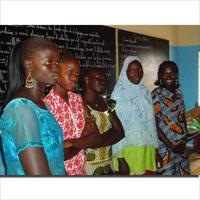MALI: Still a long way to go to meet adult literacy targets

“We have very low literacy rates in all languages here
in Mali,
and we know we need to make much faster progress,” Oumar Cissé, communications
adviser at the Mali Ministry for Women and Children, told IRIN.
According to Idrissa Diarra, education specialist at the
UN Children’s Fund (UNICEF) in Bamako,
literate adults have higher earning power, are more likely to escape poverty,
and to take the education of their children seriously.
“If women are illiterate, how can they play a strong
role in their communities, how can they take strong household decisions, and
how can they vote?” he asked.
Mali is just one of six countries (alongside Niger, Chad,
Ethiopia, Mozambique and Afghanistan) in which under 40
percent of adults are literate, according to UNICEF.
Government policy
In April 2004 the government launched the Decade of
Literacy in Missabougou, a district of Bamako. Recognising slow progress in
increasing literacy rates, it went on to divide its Education Ministry in two
in October 2007, creating a ministry of basic education and literacy in
national languages, and another to address secondary, superior education and
professional training.
“Creating a ministry solely responsible for literacy
shows the commitment we have to improving rates,” Souleymane Kone, national
director of the Basic Education, Literacy and Languages Ministry, told IRIN.
However, he said the government had still not recruited
all of its staff-members, let alone developed a national literacy strategy,
adding that he hoped it would be published in a few months.
The president has promised to allocate 3 percent of the
national education budget to adult literacy training as part of the strategy.
Education currently receives 35 percent of the overall
government budget.
But Oumar Traouré coordinator of the non-governmental
organisation Support for Quality Education (OMAES), which provides literacy
training to adults through schools in Seygou, 130km north of Bamako, told IRIN
this amount will not be enough to significantly boost the figures. “Three
percent of 35 percent is nothing,” he told IRIN.
He continued: "But it is better than nothing... at
the moment we have no electricity or teaching materials in our training
centres, and we can’t even afford to pay our teachers, so they end up leaving.”
Few teachers
The lack of literate adults to teach literacy programmes
is hampering success, according to Traouré. Many adult literacy programmes in
Malian schools are governed by school management committees but in the schools
where OMAES works, most of the management committee members are themselves
illiterate.
In particular, the lack of qualified female literacy
trainers poses problems, according to UNICEF’s Diarra, because many men are
reluctant to send female family members to learn under male teachers, so women
are often forced to drop out of programmes.
With this in mind the government is working closely with
organisations such as UNICEF and the UN Educational, Scientific and Cultural
Organization (UNESCO) to train female teachers, many of them school-leavers.
“They don’t need an advanced formal qualification -
after all, they are only teaching basic language and numeracy, not how to read
the stars,” said Diarra.
With the halfway mark for the Education for All target
behind them, Cissé hopes the time-pressure will spark results. “We should start
to see major changes this year,” she said.
Despite the enormous efforts that lie ahead, even Traoré
believes Mali
has some hope of meeting its 2015 targets. “We may get there”, he told IRIN,
“but only with lots of difficulty.”
 Back and Next - Back and Next
Back and Next - Back and Next See Also - See Also
See Also - See Also